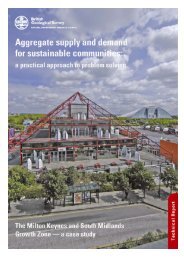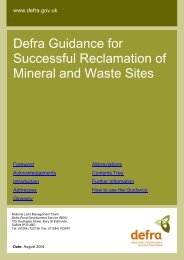creating environmental improvements through biodiversity
creating environmental improvements through biodiversity
creating environmental improvements through biodiversity
Create successful ePaper yourself
Turn your PDF publications into a flip-book with our unique Google optimized e-Paper software.
3.6 BIODIVERSITY AND MINERAL SITES – NON-ALSF RESEARCH IN<br />
ENGLAND<br />
Four reports were identified, all from English Nature, that provide useful background to this review <strong>through</strong><br />
non-ALSF research into <strong>biodiversity</strong> on minerals sites.<br />
The earliest of these was an exercise in collation of case studies, of where the minerals extraction industry<br />
had adopted working practices or schemes that were deliberately beneficial to nature conservation<br />
(Tyldesley, 1995). Although no analysis was presented of the results, this was an early attempt to gather<br />
best practice information from <strong>through</strong>out the industry. A later production by the Minerals and Nature<br />
Conservation Forum (MNCF - which includes English Nature, the Quarry Products Association and the Silica<br />
and Moulding Sands Association), provides background information on BAP targets and <strong>biodiversity</strong> for the<br />
minerals industry, identifies basic good practice, and provides pointers to relevant sources of information<br />
(EN, QPA and SAMSA, 1999).<br />
A study was commissioned by QPA and SAMSA to follow on from the 1999 guidelines, to develop a<br />
methodology that would allow the minerals industry to assess the contribution its holdings are making<br />
to <strong>biodiversity</strong>. Outputs of this were: a simple process and mechanism to audit the existing or potential<br />
<strong>biodiversity</strong> of a company’s landholdings, and: some management guidelines for illustrative purposes<br />
(Horton, 2003). The resulting guidelines are a very useful resource for minerals industry staff and should<br />
help significantly towards raising ecological knowledge, and hopefully enthusiasm, and towards standardising<br />
approaches across the industry. However they are a starting point and do not negate the need for expert<br />
advice in identifying and dealing with particular habitats. The guidelines were to be trialled and refined in<br />
cooperation with the minerals industry.<br />
Sustainable Aggregates Creating Environmental Improvements <strong>through</strong> Biodiversity<br />
A study was also commissioned by English Nature on behalf of MNCF to assess the mineral industry’s<br />
contribution to and impacts on <strong>biodiversity</strong> (SLR Consulting, 2004). This involved GIS analysis of land cover,<br />
conservation designations, BAP priority habitat inventories and species data in relation to aggregate sites.<br />
The results were combined with a review of a number of restoration plans for consented workings and<br />
synthesised into a ‘balance sheet’ showing gains and losses to <strong>biodiversity</strong> over time, within two study areas.<br />
Results showed that both gains and losses to <strong>biodiversity</strong> have occurred, while in future <strong>biodiversity</strong> gains<br />
will occur due to aggregate site restoration. The report suggests that future losses to <strong>biodiversity</strong> can be<br />
minimised by:<br />
• Full consideration of <strong>biodiversity</strong> in the planning process<br />
• Retention and appropriate management of remaining semi-natural habitats within aggregate sites, and<br />
• Sensitive, conservation-led restoration of existing aggregate sites<br />
The method was seen as a starting point for the long-term monitoring of the <strong>biodiversity</strong> contribution made<br />
by the aggregates industry. The report states that ‘monitoring <strong>biodiversity</strong> will be a key factor in determining<br />
the long-term sustainability of the industry’. The main points made by the report are very much in keeping<br />
with the recommendations made in this review.<br />
29

















